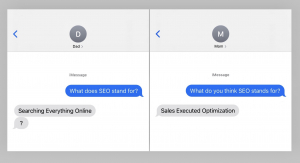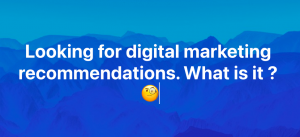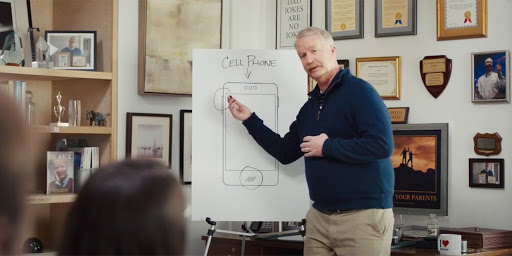How to Explain Digital Marketing to Your Parents
We all remember a time when we helped a parent or grandparent navigate the world of modern technology. Whether it’s not knowing how to log into Facebook, which button on the remote will turn on the TV, or how to use ‘the Google,’ Gen Z and millennial kids have been there. And no, Mom, Gen Z does not stand for Generation Zuckerberg. It’s time to proactively teach our parents and grandparents the next steps of the internet: digital marketing. Mom and Dad, this goes a little bit beyond “Siri is listening to me,” or “Google is finishing my sentences.” Specifically written for my parents who aren’t sure what I do at work, this is: how to explain digital marketing to your parents.
What is digital marketing?
Marketing has always been about finding a way to connect with your audience in an effective way. It can be grouped into two different types: traditional and digital.
Most consumers are familiar with traditional marketing, because it’s been around the longest. This strategy uses platforms like billboards, magazines, radio, mail, or TV to send a message. Digital marketing includes everything you find online: search engine optimization, paid advertising, social media, website design, video, and more. To clarify Mom, those ‘ads that follow you on Facebook,’ are in fact digital marketing.
In a company, traditional advertising might exist in print ads or phone communication. Digital marketing exists electronically and online. The possibilities are endless when it comes to reaching customers. Companies can utilize email marketing, optimize their website, or enhance their social media profiles. Why teach an old dog new tricks? Keep reading.
Why do companies need digital marketing?
There’s no question the pandemic only created an increase in online presence. According to Statistica, there was a 39% increase in online transactions from January 2020 to January 2021. Additionally, the global conversion rate increased by 40%. It became a necessity to have an online presence.
According to research from ZoomInfo, 72% of adults prefer digital communication with companies. While traditional marketing channels persist for many business, it’s clear how important it is to make the digital push. At this point, consumers expect to see a mix of both strategies. Most businesses at least have one of the following: website, social media presence, or ad strategy. Digital marketing is vital when it comes to informing customers and building brand loyalty.
What in the world does SEO stand for?

Close but no cigar, Mom and Dad. This stands for Search Engine Optimization. Search Engine Optimization is the process of increasing volume and quality of traffic to your site via search engine rankings. Search engines like Google and Bing use bots to crawl websites, read information and index that collected information. Okay, maybe we need an example. If a page of a website is like a page of a book, then Google is a librarian. Google algorithms are designed to find relevant, authoritative pages and give users an efficient experience. To create a higher ranking page, sites and content are optimized to meet these criteria.
So Mom, in a way, Google is listening to you when you search for ‘clothing store near me.’ This is SEO working to provide search queries that warrant localized results. Localized SEO utilizes the Google Map pack to drive exposure, clicks, and eventually sales. The map pack is that convenient map that “always asks for your location”’ when you search. Dad, those “little stars and reviews” on different shoe store websites are where Google MyBusiness comes into play. Utilizing this tool is vital in an SEO strategy. It allows companies to manage how they appear locally on Google by scanning for the following:
- Business Name
- Categories
- Location
- Service Area
- Business Hours
- Phone Number
- Website
- Services
- Description
- Reviews
The more information a customer has about your business, the easier it is for them to make a decision. Local SEO and Google MyBusiness can work together to help you communicate directly with local customers, promote sales and events, and make your business more engaging. Whether SEO is being optimized locally, nationally, or for an e-commerce site, the strategy remains the same. For my parents who have read this far but still aren’t understanding, here’s the process:
Every good strategy starts with business research and goal expectations. After gaining a thorough understanding of your business and what brings you conversions, we move to keyword research. Because SEO is so competitive, is it essential to have relevant, high search volume keywords to boost rankings. Next, we move to on-page and off-page optimization. On-page SEO starts with placing those keywords in content for the website. The more keywords we can get on a site, the more relevancy and authority it builds! Off-page SEO, or link building, is everything that goes on behind the scenes.
Seems easy enough, right? Not quite. For keywords to start hitting the first page of Google, it can take up to six months. Think of SEO like getting to the airport, it takes time. Content optimization and link building are optimized on a monthly basis. For example: if February is a content month, then March is link building, April is content, and so on. Remember how I mentioned Google uses bots to crawl pages? It takes patience as these pages to index. However, when we start seeing key performance indicators like impressions, traffic, rankings, and conversions work in our favor – we don’t stop there. Dad, think of SEO like the front lawn during summer time – we just can’t stop watering it.
If you’re wondering if you can pay Google to rank higher, the answer is no. Unless, you’re referring to Pay-Per-Click advertising.
Ok, got it. Now, what are paid ads?
People search on Google for everything: what to do, where to go, and what to buy. Having advertisements on Google can turn those searches into valuable conversions. While there are several different aspects of digital advertising, PPC (Pay-Per-Click) ads are the most common.
It allows users to bid on industry-specific keywords, but only pay when the ad gets clicked on (hence, pay per click). When we say bidding war, think less ‘fast talking auctioneer’ and more ‘simple click of a button online.’ There are several different bid strategies available, each depending on what goals you have in mind.
The main goal of Google Ads is like any other: increase leads. Marketing via Google search gives you the added benefit of knowing exactly where those leads are coming from. Through Google Ads we are able to track every click, call, form fill, and purchase. Because search engine marketing is based on showing up for what people search, you could be showing your ads to those who are ready to buy now. The best part? Your ads could be on page 1 of Google within minutes. This is a highly controlled service; meaning you can pick and choose where ads and keywords are showing up. No mom, the “Ad” icon you see next to a search result does not mean “this is spam.”
What about the ads I see on Facebook?
Other digital advertising services include social media ads, or display marketing. To all the Facebook moms who have clicked on an ad without knowing and had that ad “follow them around,” this is for you. Social media, the fastest growing advertising channel, works to build awareness on networking platforms such as Facebook, Instagram, Twitter, Snapchat, LinkedIn, TikTok, and more. Facebook, the most common channel, is popular for its hyper-targeted advertising abilities. With Facebook ads, we can track users based on location, demographic, and profile information. Facebook ads are more like display ads than search ads. If you’ve ever seen an ad for something and thought “maybe I would like that,” the ad worked.
Display advertising is as creepy and effective as it gets. Dad, remember that time you left a pair of boots in your shopping cart, then every website you visited displayed an ad for boots? That was a digital marketing strategy. Display ads are a way to connect with people who previously interacted with your website or mobile app. You can strategically position these ads in front of audiences as they browse Google, thus helping you increase your brand awareness or remind those audiences to make a purchase. Let’s be honest, the creepy reminders work.
Are Facebook ads different from social media marketing?
Yes. Facebook Ads are a form of paid social media, while social media marketing is a way to organically connect with an audience. I’ll hand it to you Mom, you know more about social media that you think. When you’re checking in on Facebook, or accidentally creating an Instagram account, you’re utilizing social media channels for person use. Dad, when you reshare company LinkedIn posts and retweet articles, you’re utilizing social media channels for corporate use. According to Statisitca, In 2021, 91% of U.S. marketers in companies larger than 100 employees were expected to use social media for marketing purposes. In 2013, the share stood only at 86%.

Why do I bring this up? Because behind every good marketing strategy is an ever better social media plan. Social media marketing is so much more than liking, commenting and posting. It’s crafting well-executed strategies, building relationships, and optimizing profiles. Every social media plan starts with discovery: finding your brand’s strengths, weaknesses, and challenges. From there, we can craft actionable and achievable goals. For example, if it’s become a challenge to gain followers and spread the word, we can make a goal to increase brand engagement and impressions. For my mom who thinks scrolling TikTok is an impression, let me backup.
Some of the metrics used in social media marketing include: engagement, impressions, reach, and conversions. The metrics are used to measure the actionable goals set in the strategy meeting. To explain further: Mom, let’s pretend you’ve just posted on Facebook and the post has 150 engagements, 1,000 impressions, and reached 1,500 people. This means 150 people interacted with your post (either liked, commented, or mentioned you), it showed up 1,000 users’ feeds, and 1,500 people saw the post either directly or through a mutual friend. Unfortunately Mom, I don’t think your metrics are this high… yet.
What else can social media do?
Beyond creating an online presence and gaining a following, social media allows your brand the opportunity to be creative. You can hold contests/giveaways, hire influencers, and explore new ways to present media! And no Dad, I am not an influencer because my friends follow me. Creating a great, attentioning grabbling video to post online, could go viral in a week. Let’s use another example, say you’re looking for a local hair salon on Facebook. Are you choosing the page with high definition photos, fun videos, and tons of followers, or the salon that has four photos from 2015 and hasn’t posted in weeks? Social media is essential in customer decision making. A business could be just a few content calendars away from a world more of leads.
To recap…
An Instagram post is more engaging than a postcard. A banner ad is more clickable than a billboard. Search engine optimization is more effective than searching a magazine.
If my parents have made it this far, I’ll consider it a lesson learned. If they can tell me what SEO stands for without cheating, even better. Digital marketing is more than just a pretty website and fun social media, it’s an essential piece of the marketing puzzle. Whether you’re starting a business or have been in a business for years, rethink a digital marketing strategy. With a world full of Google searches, Siri questions, and Amazon shopping, why not take advantage of it? Driving leads, traffic, and conversions to your website in a manageable, trackable way is a no-brainer. For the grandparents, Gez Z kids, and everyone in between, welcome to the age of digital advertising. We’re here to help.
